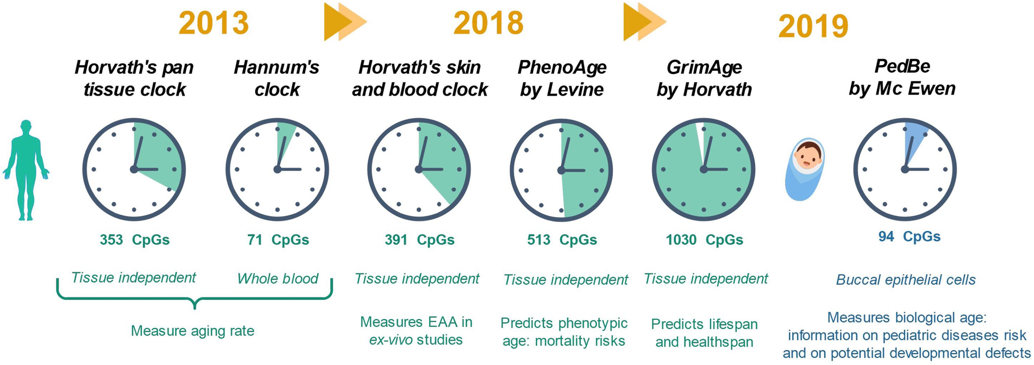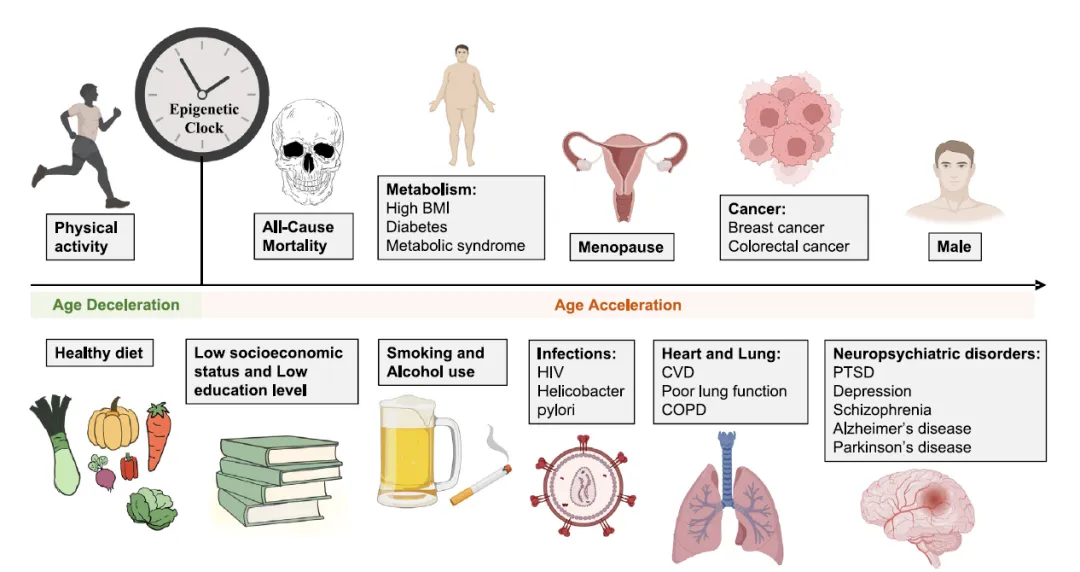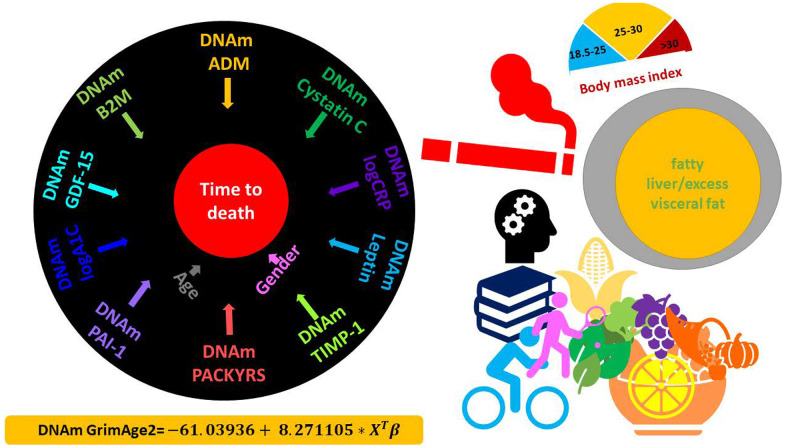



March 19.2024
Exploring the epigenetic clock: Revealing the secrets of life's aging code.
In biology, the concept of time is not just a simple unit of measurement; it is also a profound and complex topic. As time passes, organisms undergo a series of changes, which are reflected not only in their external forms but also in the gene expression and epigenetic regulation within cells. The World Health Organization predicts that by 2050, there will be 2.1 billion people globally aged 60 and older, far exceeding the 1 billion in 2019. With the rapid acceleration of population aging and the rapid expansion of the elderly population, there is an urgent need to develop strategies to ensure the extension of 'HealthSpan' or healthy longevity.
To better understand and address this challenge, scientists have developed epigenetic clocks for assessing human physiological age.
CpG sites are considered indicators for assessing aging using epigenetic clocks because as age increases, dynamic changes occur in CpG sites within DNA, which are closely related to the aging process. Scientists have found that the DNA methylation patterns of CpG sites are correlated with an individual's age, thus these specific DNA methylation patterns can be used to assess the degree of aging in an individual. This correlation makes CpG an important indicator for assessing aging using epigenetic clocks. [1]
When the epigenetic clock contains more CpG sites, its accuracy and reliability in assessing aging are higher. Currently, there are four epigenetic clocks widely used, and their accuracy rankings are as follows: GrimAge (1030 CpG sites), PhenoAge (513 CpG sites), Horvath (353 CpG sites), and Hannum (71 CpG sites).

The Horvath Clock
The Horvath Clock is an epigenetic clock developed by Professor Steve Horvath of the University of California, Los Angeles in 2013. It is a method that assesses the entire genome using DNA methylation patterns and can accurately estimate human biological age. DNA methylation is a chemical modification that occurs at CpG sites. The presence or absence of methyl groups at specific CpG sites may indicate age-related changes in DNA[2]. The Horvath Clock utilizes DNA methylation patterns at specific CpG sites to create a model that predicts an individual's biological age.
The Hannum's Clock
Hannum's Clock is an epigenetic clock developed by the scientific team led by Hannum in 2013, used to estimate biological age. This clock is based on DNA methylation patterns and utilizes around 71 specific CpG sites to predict an individual's biological age. The experiment established a quantitative model of aging by measuring over 450,000 CpG markers in the whole blood of 656 human individuals aged between 19 and 101 years old [3].
The main difference between the two lies in the number of CpG sites used and the selected tissue types. The Hannum clock utilizes fewer CpG sites, around 71, while the Horvath Clock uses 353 CpG sites. Additionally, the Hannum clock was developed and validated in blood samples, while the Horvath Clock has been shown to be effective in multiple tissue types.
The PhenoAge Clock
The PhenoAge Clock is an epigenetic clock developed by a team of scientists led by Levine, used to estimate biological age. Unlike traditional DNA methylation-based clocks such as the Horvath Clock and Hannum Clock, the PhenoAge Clock is based on a range of health-related physiological markers such as blood biochemical markers, inflammation markers, and nutritional indicators to predict an individual's biological age and reflect their overall health status [4].

It is worth noting that among the 513 CpG sites in PhenoAge, only 41 are shared with the Horvath clock, and there are only five CpG sites shared among the three clocks (DNAm PhenoAge, Horvath, and Hannum). This indicates an improvement in DNAm PhenoAge clock compared to previous epigenetic biomarkers of aging.
GrimAge
In 2022, the Horvath team developed version 2 of GrimAge. Compared to GrimAge released in 2019, the similarities lie in both being based on DNA methylation data and a range of other biomarkers to predict an individual's biological age, including plasma proteins, pack-years of smoking, etc [5]. Both use elastic net regression models for training and prediction to obtain predicted values for the target biomarkers. Additionally, they regress these predicted values against time to death for all causes using Cox regression models to construct age estimates.

However, the main difference between GrimAge and GrimAge2 lies in the variables used during construction. GrimAge is based on covariates including age, sex, DNAm PACKYRS, and seven DNAm-based proteins, while GrimAge2 adds two new biomarkers based on DNAm, which are high sensitivity C-reactive protein and hemoglobin A1C.
GrimAge2 does not replace existing clinical biomarkers. Instead, when assessing an individual's aging rate, GrimAge2 complements existing clinical biomarkers.
The Prospects of Epigenetic Clocks
Epigenetic clocks, as an emerging tool in biology, reveal the secrets of life's passage of time. By accurately measuring the age of organisms, epigenetic clocks can predict not only health and disease risks but also provide new breakthroughs in aging research, cancer treatment, regenerative medicine, and other fields. With further understanding of the mechanisms behind epigenetic clocks and continuous technological advancements, it is believed that they will play an increasingly important role in the future, offering more possibilities for human health and longevity.
In the pursuit of reversing the aging process, companies like Botanicure are leveraging the insights gained from epigenetic clocks to develop innovative anti-aging solutions.
Through advanced research and development, Botanicure has identified key botanical compounds that have shown promise in modulating epigenetic markers associated with aging. These compounds are carefully formulated into products that not only address external signs of aging but also work at a cellular level to reset epigenetic clocks and restore youthful vitality.
By combining scientific rigor with nature's healing power, Botanicure aims to redefine the possibilities of aging gracefully and maintaining optimal health. As the field of epigenetics continues to evolve, companies like Botanicure remain at the forefront of anti-aging innovation, offering hope for a future where age is just a number and vitality knows no bounds.
Reference:
[1] Horvath, S. DNA methylation age of human tissues and cell types. Genome Biol 14, 3156 (2013). https://doi.org/10.1186/gb-2013-14-10-r115
[2] Horvath S. DNA methylation age of human tissues and cell types. Genome Biol. 2013;14(10):R115. doi: 10.1186/gb-2013-14-10-r115. Erratum in: Genome Biol. 2015;16:96. PMID: 24138928; PMCID: PMC4015143.
[3] Hannum G, Guinney J, Zhao L, Zhang L, Hughes G, Sadda S, Klotzle B, Bibikova M, Fan JB, Gao Y, Deconde R, Chen M, Rajapakse I, Friend S, Ideker T, Zhang K. Genome-wide methylation profiles reveal quantitative views of human aging rates. Mol Cell. 2013 Jan 24;49(2):359-367. doi: 10.1016/j.molcel.2012.10.016. Epub 2012 Nov 21. PMID: 23177740; PMCID: PMC3780611.
[4] Levine ME, Lu AT, Quach A, Chen BH, Assimes TL, Bandinelli S, Hou L, Baccarelli AA, Stewart JD, Li Y, Whitsel EA, Wilson JG, Reiner AP, Aviv A, Lohman K, Liu Y, Ferrucci L, Horvath S. An epigenetic biomarker of aging for lifespan and healthspan. Aging (Albany NY). 2018 Apr 18;10(4):573-591. doi: 10.18632/aging.101414. PMID: 29676998; PMCID: PMC5940111.
[5] Lu AT, Binder AM, Zhang J, Yan Q, Reiner AP, Cox SR, Corley J, Harris SE, Kuo PL, Moore AZ, Bandinelli S, Stewart JD, Wang C, Hamlat EJ, Epel ES, Schwartz JD, Whitsel EA, Correa A, Ferrucci L, Marioni RE, Horvath S. DNA methylation GrimAge version 2. Aging (Albany NY). 2022 Dec 14;14(23):9484-9549. doi: 10.18632/aging.204434. Epub 2022 Dec 14. PMID: 36516495; PMCID: PMC9792204.
Previous : No more
Next : Nectandrin B